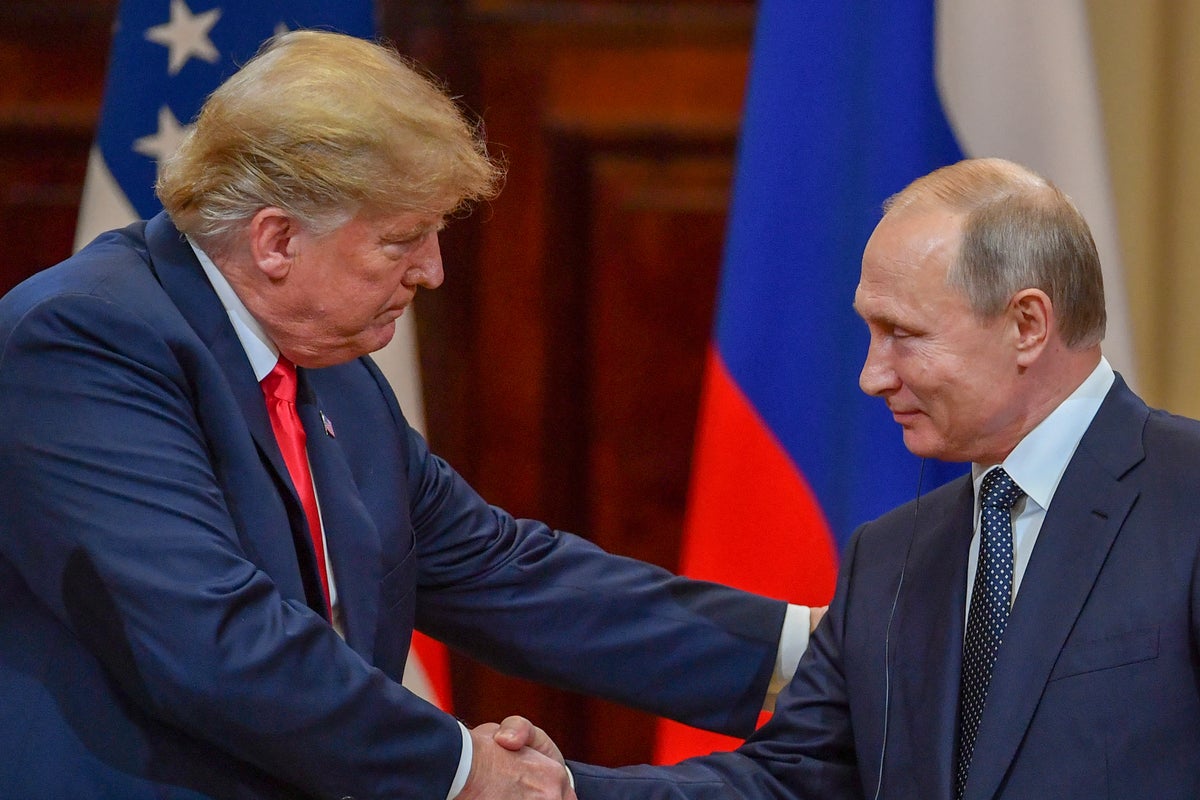Latest News
Another week, another deadline: Timeline of Trump’s promises to end Russia’s war on Ukraine
Published
4 months agoon
By
cldhaz
Donald Trump has claimed the end of the Ukraine war could come in weeks, despite his latest deadline for Vladimir Putin to agree to a ceasefire expiring in a matter of hours.
Last Monday, Trump dramatically shortened his previous 50-day ultimatum, giving Russia “10 to 12 days” to make progress toward peace or face tougher sanctions.
Sources close to the Kremlin say Putin is unlikely to bow to Trump’s threats, believing Russia holds the upper hand in the war and that the potential benefits of improved ties with Washington do not outweigh his military aims.
Still, an agreement has been reached for Putin and Trump to meet “in the coming days” to discuss a ceasefire – a first since Joe Biden met with Putin in Geneva in 2021.
The talks follow a three-hour meeting between Trump’s special envoy Steve Witkoff and Putin in Moscow.
Donald Trump and Vladimir Putin are set to meet to discuss Ukraine’s future (AFP/Getty)Trump has made a meeting between Putin and Ukrainian President Volodymyr Zelensky – which would be a first since the invasion began in February 2022 – a condition of a US-Russia meeting. So far, Putin has not conceded.
Having repeatedly vowed to end the war “within 24 hours” of taking up office, Trump now faces mounting pressure as his deadlines slip and Putin shows no sign of backing down.
But his growing “disappointment” in Putin and sanction threats suggest his patience is wearing thin.
Here, The Independent looks at the times Trump has set deadlines for Russia:
On the campaign trail
While campaigning for a second term in office, Trump said dozens of times he would end the war in Ukraine within 24 hours of returning to the White House.
He repeatedly asserted he would have the war “settled” if he became president again, including at both presidential debates of 2024.
CNN has counted at least 53 occasions between March 2023 and October 2024 that Trump made such comments.
20 January, Inauguration Day
Trump reiterated his desire to end the war when he was inaugurated, although no explicit deadline was given.
“Our power will stop all wars and bring a new spirit of unity to a world that has been angry, violent, and totally unpredictable,” the US President said in his Inaugural Address.
Later that day, he discussed Putin to reporters: “I mean, he’s grinding it out, but most people thought that war would have been over in one week, and now we’re into three years. So he can’t be thrilled, [it’s] not making him look very good.”
‘Our power will stop all wars,’ Trump said in his Inaugural Address (Getty)22 January, the first 48 hours
By 22 January, Trump had not spoken to Putin since he was sworn in but he said his aides were working to arrange a conversation.
He threatened unspecified sanctions on Moscow if Putin didn’t come to the negotiating table ‘soon’. In a post on his Truth Social platform, Trump said he was “not looking to hurt Russia” and expressed “love” for the Russian people.
The president boasted of his “very good relationship” with Putin – who in 2016 ordered what the Department of Justice called a “sweeping and systematic” effort to interfere in the presidential election on Trump’s behalf. Trump has repeatedly claims that interference in the election is a “hoax”.
“All of that being said, I’m going to do Russia, whose Economy is failing, and President Putin, a very big FAVOR. Settle now, and STOP this ridiculous War! IT’S ONLY GOING TO GET WORSE,” Trump said.
Russia’s deputy UN ambassador Dmitry Polyanskiy said Moscow would need to see what Trump’s definition of a “deal” would look like before coming to the negotiating table.
12 February, Putin-Trump call
Trump said he spoke to Putin and agreed to ‘immediately’ start talks on ending Ukraine war in the two leaders’ first direct exchange since the invasion.
He claimed Putin agreed to closely cooperate and host official visits, and that their teams would begin negotiations right away.
The call marked a break-away from the Biden administration policy to not discuss Ukraine without Kyiv’s presence. He said he later spoke with Zelensky but did not commit to making Ukraine an equal participant to US negotiations with Russia.
It came as his defence secretary announced an end to longstanding US policy supporting Ukrainian membership in NATO.
In response, Zelensky maintained a brave face, saying he had a “meaningful conversation” with Trump and that Kyiv was ready to “work together at a team level”. Kremlin spokesman Dmitry Peskov said Putin emphasised the need to remove the war’s “root causes” but that settlement could be reached through peace talks.
28 February, The Oval Office meeting
The infamous meeting between Trump and Zelensky in the White House (Getty Images)By month’s end and moments after saying he wished to be remembered as a “peacekeeper,” Trump berated Zelensky in the tense Oval Office meeting, as press and stunned diplomats looked on.
With support from his deputy, JD Vance – who repeatedly pressed Zelensky on whether he’d ever said “thank you” for US military assistance – Trump condemned the Ukrainian leader as “disrespectful” and called off a minerals deal he had touted as a step toward peace.
Claiming to be “caught in the middle”, he cited Zelensky’s “hatred” for Putin as a major obstacle to ending the war.
Trump suspended military aid to Ukraine on 3 March. The next day, Zelensky extended an olive branch to Trump and said the showdown was “regrettable” and remained committed to cooperating over a peace deal.
14 March, ‘24-hour promise was sarcastic’
Trump claimed he was “being a little bit sarcastic” when he repeatedly said as a candidate that he would end the war within 24 hours.
In the following days he spoke with both Zelensky and Putin on successive days.
In one call on 18 March, Putin refused to back Trump’s suggested full 30-day ceasefire but agreed not to target Ukraine’s energy infrastructure.
The next day, Trump proposed that Zelensky consider handing over ownership of Ukraine’s power plants to the US for security – an idea Zelensky strongly rebutted.
14 April, Trump blames everyone for no deal
By 14 April, Trump blamed everyone: Zelensky, Putin and Biden.
“That’s a war that should have never been allowed to start and Biden could have stopped it and Zelensky could have stopped it and Putin should have never started it,” Trump said.
He proceeded to alternate blame between Zelensky and Putin. On 23 April, Trump said Zelensky was prolonging the “killing field” after pushing back on ceding Crimea to Russia as part of a potential peace plan. He added that Zelensky’s stance was “very harmful” to talks and that a deal had been close.
The next day, he urged Putin to stop after Russia’s deadly barrage of assaults on Kyiv – at the time it was the biggest attack since the summer before. “I am not happy with the Russian strikes on KYIV. Not necessary, and very bad timing. Vladimir, STOP! 5000 soldiers a week are dying,” Trump said in a post on his Truth Social platform. “Lets get the Peace Deal DONE!”
Rubio warned the US may abandon Ukraine peace talks if progress was not made in the coming days.
28 May, two-week deadline
Asked about Russia’s escalating violence in Ukraine, Trump appeared to issue a two-week deadline for Vladimir Putin to demonstrate he actually wants to end the war.
Pressed on whether he thought Putin wanted to end the war, Trump said: “I can’t tell you that, but I’ll let you know in about two weeks.”
“Within two weeks. We’re gonna find out whether or not (Putin is) tapping us along or not. And if he is, we’ll respond a little bit differently.”
The comments came as the Kremlin ramped up its attacks on Ukraine, including some of the deadliest attacks of the war, and were a sign of Trump’s growing frustration at the lack of efforts to achieve peace.
Trump is set to meet Putin next week (Copyright 2025 The Associated Press. All rights reserved)14 July, 50-day deadline
Trump announced the US could impose “very severe” secondary tariffs, potentially 100 per cent, on Russia if the war in Ukraine is not concluded within 50 days.
He expressed strong disappointment with Russian President Putin, accusing him of being “all talk” and condemning Russia’s attacks on Ukrainian civilian targets.
While the US does not have a current trade relationship with Russia, following Biden’s sanctions, secondary tariffs aimed to punish countries buying Russian oil. China and India are among the biggest purchasers and refine the oil for export elsewhere.
But rather than be spooked, the Russian stock market rose by 2.7 per cent as the country had expected tougher sanctions.
28 July, shortens deadline 10-12 days
Trump again said he is “very disappointed” in Putin and that he’s cutting Moscow’s 50-day deadline to avoid secondary sanctions on Russian oil to between 10 and 12 days from then, unless Putin ends the war.
Speaking alongside Prime Minister Sir Keir Starmer on the steps of his Turnberry golf resort in Scotland, Trump complained that Putin had too often talked a good game about wanting to reach a ceasefire in the conflict only to resume bombing civilian targets in short order.
As Trump grew significantly frustrated with Putin in recent weeks, he gave him until Friday 8 August to make progress toward peace in Ukraine or face tougher sanctions.
However, the day before the deadline the Kremlin said Putin would be meeting with Trump next week.


Widest 5G Coverage, the Launch of the Uplay Platform, and the Integration of Cerillion: Ucom Summarizes 2025

Iran reports 3 security forces, 1 civilian killed in border clash

Darts player brings insect spray on stage as wasps wreak havoc at worlds

Artsakh has no natural gas for 4th day, negotiations with Azerbaijan continue

Italy’s Palermo unanimously recognizes Artsakh independence

Captured in Artsakh terrorist says they were promised $ 100 for each severed head of ‘kafir’

NEWS.am latest, 03.11.20: Nagorno-Karabakh authorities have evidence of Azerbaijan using prohibited weapons in Artsakh

Captured in Artsakh terrorist says they were promised $ 100 for each severed head of ‘kafir’

